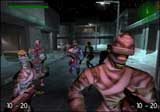 The people of Free Radical Design,
former Rare programmers and part of the machine responsible for Goldeneye on the N64, have
released their debut First-Person Shooter for the PS2. For those of you who are squirming
with anticipation, go ahead, get excited. Sure, for this game, which is fun, but more
importantly for the future, because it should only get better.
The people of Free Radical Design,
former Rare programmers and part of the machine responsible for Goldeneye on the N64, have
released their debut First-Person Shooter for the PS2. For those of you who are squirming
with anticipation, go ahead, get excited. Sure, for this game, which is fun, but more
importantly for the future, because it should only get better.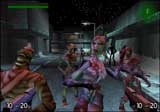 Like so many gamers, the release of
Goldeneye forever changed the way I look at games. I never stopped playing Goldeneye until
Perfect Dark usurped it. And I will be playing Perfect Dark in all of its possible
configurations until another game tops it. Is TimeSplitters that game? No. But, while this
is the obvious comparison, it is an unfair one. Those titles focused on the single-player
games, with strong stories, steady pacing, stealth and gadgetry, in addition to having a
multi-player mode. TimeSplitters focuses on being a kick-ass multi-player game, little
else. It is fast and deadly, with strong arena and cooperative elements as well as a map
builder. It is competing with games like Unreal Tournament and Quake III Arena.
Like so many gamers, the release of
Goldeneye forever changed the way I look at games. I never stopped playing Goldeneye until
Perfect Dark usurped it. And I will be playing Perfect Dark in all of its possible
configurations until another game tops it. Is TimeSplitters that game? No. But, while this
is the obvious comparison, it is an unfair one. Those titles focused on the single-player
games, with strong stories, steady pacing, stealth and gadgetry, in addition to having a
multi-player mode. TimeSplitters focuses on being a kick-ass multi-player game, little
else. It is fast and deadly, with strong arena and cooperative elements as well as a map
builder. It is competing with games like Unreal Tournament and Quake III Arena.
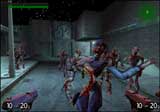 That said,
TimeSplitters is divided into two types of gameplay: Story Mode and Arcade Mode. Story
Mode is a deceptive title to say the least, because there simply is no story. Essentially,
it is a group of levels, set throughout history (1930’s Egypt, 70’s Chinatown,
an alien planet, etc.), in which you are presented with the same challenge: battle your
way through the level, find an object, and take it to the checkpoint before the
TimeSplitters show up and kill you. There are no beginning, middle, or ending FMV’s.
There isn’t even a beginning, middle, or end. You chose the levels in any order and
play as a different character each time. Fine, I can deal with that, I even enjoyed it,
but don’t call it a Story Mode. Call it a "Come in and get a feel for the game
while unlocking new levels and options for the multi-player games mode." Or
something. Basically, that is all you will play Story Mode for: new options. You can do
this alone, or, by the grace of Free Radical, take along a friend for some two-player
cooperative gameplay.
That said,
TimeSplitters is divided into two types of gameplay: Story Mode and Arcade Mode. Story
Mode is a deceptive title to say the least, because there simply is no story. Essentially,
it is a group of levels, set throughout history (1930’s Egypt, 70’s Chinatown,
an alien planet, etc.), in which you are presented with the same challenge: battle your
way through the level, find an object, and take it to the checkpoint before the
TimeSplitters show up and kill you. There are no beginning, middle, or ending FMV’s.
There isn’t even a beginning, middle, or end. You chose the levels in any order and
play as a different character each time. Fine, I can deal with that, I even enjoyed it,
but don’t call it a Story Mode. Call it a "Come in and get a feel for the game
while unlocking new levels and options for the multi-player games mode." Or
something. Basically, that is all you will play Story Mode for: new options. You can do
this alone, or, by the grace of Free Radical, take along a friend for some two-player
cooperative gameplay.
The Arcade Mode is the heart of the game. A free-for-all in the level of your choice,
you can configure a single- or multi-player (up to four-players with the multi-tap,
split-screen) game with or without computer controlled bots. All of the usual game styles
apply—Deathmatch, Capture the Bag, etc. There is also a new addition with Last Stand,
where you or your team defend a perimeter filled with crystals that your enemies want to
destroy. Oh, and at the center of that perimeter—a turret-mounted cannon that you
control. Pretty cool, if a tad limited.
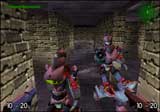 The
gameplay in TimeSplitters is fast and furious, logic be damned. Watch your butt is the
best strategy. Oh, and a big gun helps, and there are certainly enough of them here. All
of the weapons more or less fall into the semi-auto, auto, scattershot, or explosive
category, but each is imaginative and fun, the alien arsenal especially, and there is good
balance throughout. Fans of Goldeneye and Perfect Dark will appreciate the timed, remote,
and proximity mines.
The
gameplay in TimeSplitters is fast and furious, logic be damned. Watch your butt is the
best strategy. Oh, and a big gun helps, and there are certainly enough of them here. All
of the weapons more or less fall into the semi-auto, auto, scattershot, or explosive
category, but each is imaginative and fun, the alien arsenal especially, and there is good
balance throughout. Fans of Goldeneye and Perfect Dark will appreciate the timed, remote,
and proximity mines.
The control in TimeSplitters centers on the dual analog joysticks and shoulder buttons
of the PS2 controller. In default setting you use the left stick to move forward,
backward, and strafe, while with the second you look up and down, turn right and left.
Your fire buttons are on the right shoulder, crosshairs and crouch on the left. Then you
have right and left weapons scroll and reload buttons on the directional pad and button
pads, respectively. This is probably the configuration that best allows you to run and aim
with your crosshairs at the same time. You can, however, change the control system to your
liking, in mid-game no less, so you can reconfigure and test your controls as often as you
like.
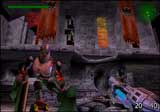 The
graphics in this game shine. At a smooth and constant 60fps, they both keep up with the
game’s chaos and help to create it. No perspective haze, no draw-in, very little
shimmer, everything is crisp and clear as far as the eye can see. This not only makes for
a lovely game, but it helps long distance shots tremendously.
The
graphics in this game shine. At a smooth and constant 60fps, they both keep up with the
game’s chaos and help to create it. No perspective haze, no draw-in, very little
shimmer, everything is crisp and clear as far as the eye can see. This not only makes for
a lovely game, but it helps long distance shots tremendously.
The sound is perfect. I mean that—perfect. Sure, the bangs, the booms, the
jingling of bullet shells on the pavement are there. But other effects, like shrill and
haunting zombie vocals, are the best I’ve heard in awhile. And better yet is the
music. From heart-pounding techno faire (I especially liked the theme for the alien
planet), to theatrical organ music in the gothic haunted mansion, and the cheesy
Kirk-without-his-shirt-fighting-the-alien-on-his-own-turf scores, it all works.
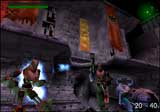 Add all of
this to the inspired settings, and you get great atmosphere. This game practically screams
campy, B-grade sci-fi/action flick. The 2035 spaceport is the tour de force. You start in
a plaza frequented by hover-taxis and plastered with vacation posters of faraway planets.
As you make your way through the lobby, the intercom chimes in with flight information,
much like a real airport. And soon after the announcer finishes the announcement in
English, another chime and, presumably, the same information in several alien dialects. It
is hilarious. And to top it all off—the crazy rocket ship that looks like all of the
old strung-by-a-wire 50’s movie models. Two things are conspicuously absent, however.
One is the total lack of bystanders. You would think that, especially in a working
spaceport, you might run into John Q. Public every now and then. Also, there is no gore.
Sure, a zombie’s head pops off every now and then, but come on. Even without the
gore, the concept is the same—you are walking around shooting people. Parents know
this. Just give us what we want.
Add all of
this to the inspired settings, and you get great atmosphere. This game practically screams
campy, B-grade sci-fi/action flick. The 2035 spaceport is the tour de force. You start in
a plaza frequented by hover-taxis and plastered with vacation posters of faraway planets.
As you make your way through the lobby, the intercom chimes in with flight information,
much like a real airport. And soon after the announcer finishes the announcement in
English, another chime and, presumably, the same information in several alien dialects. It
is hilarious. And to top it all off—the crazy rocket ship that looks like all of the
old strung-by-a-wire 50’s movie models. Two things are conspicuously absent, however.
One is the total lack of bystanders. You would think that, especially in a working
spaceport, you might run into John Q. Public every now and then. Also, there is no gore.
Sure, a zombie’s head pops off every now and then, but come on. Even without the
gore, the concept is the same—you are walking around shooting people. Parents know
this. Just give us what we want.
Also missing is the background interactivity you find in other games. I blame this on
the focus of the game, as Unreal Tournament lacks this as well. When they put together a
complex single-player mode where you must pick up objects, manipulate them, open doors,
sneak through levels undetected, that sort of thing, it naturally bleeds through to the
multi-player mode. The levels have opening doors and such already. But what it results in
is a totally different aspect of strategy—like closing doors when you are being
chased to slow your attacker down, or firing through bullet-proof windows with a .357
magnum (a la Goldeneye and Perfect Dark). Okay, in Chinatown you can shoot plates off of
the walls in the kitchen and the windows shatter in a location specific to your shots, but
everything else—doors, tables, and such, are all just back-drop. This makes for a
pretty shallow environment, even though the level-design is quite capable.
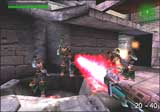 And
finally, the single greatest addition to the replay value of TimeSplitters—the map
builder. If you are like me, you approach these things with a little skepticism. I have
just been disappointed too many times. But this thing is slick. You are given a grid on
which you can build a single to eight story map using various partitions, corners, stair
cases, pre-assembled room configurations, etc. You may chose where weapons, items, and
character spawn points appear, the kind of lighting you want, and, of course, your
map’s appearance, or "skin" (taken from the original game levels). And,
incredibly, since the game only saves the map’s configuration, and adds the skin when
it loads, it uses very little memory to store your designs, so you can create dozens and
not even notice the bite it takes out of your memory card.
And
finally, the single greatest addition to the replay value of TimeSplitters—the map
builder. If you are like me, you approach these things with a little skepticism. I have
just been disappointed too many times. But this thing is slick. You are given a grid on
which you can build a single to eight story map using various partitions, corners, stair
cases, pre-assembled room configurations, etc. You may chose where weapons, items, and
character spawn points appear, the kind of lighting you want, and, of course, your
map’s appearance, or "skin" (taken from the original game levels). And,
incredibly, since the game only saves the map’s configuration, and adds the skin when
it loads, it uses very little memory to store your designs, so you can create dozens and
not even notice the bite it takes out of your memory card.
The frustrating thing about TimeSplitters is not what they have included -- what is
there is awesome. It is what was left out. I know the current trend is to focus on either
the single- or multi-player aspects of an FPS, to make the game one or the other. But
given their success on previous games like Goldeneye, I had hoped the people at Free
Radical wouldn’t have limited themselves so. I guess, with both this and Unreal
Tournament available at PS2 launch, the big question is which one should you buy? Both
have high and low points, but my money is with TimeSplitters. The map builder alone pushes
Unreal out of the running, but I like the campy tone as well. And let’s just see what
these guys come up with next, when they don’t have a launch date hurrying their work.
